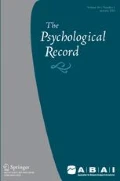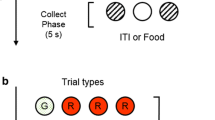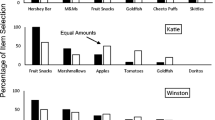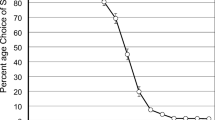Abstract
The preference-for-signaled-shock (PSS) phenomenon is theoretically important, but the relevant data base, even when limited to symmetrical-choice procedures is not unequivocal. The two experiments using rats as subjects reported here were designed to determine whether increasing the salience of the contrast between signaled and unsignaled states would increase both the strength of preference as well as the specifiability of the controlling parameters. Experiment 1 increased the contrast between signaled and unsignaled conditions by using a different frequency for tone preceding shock (signaled). The results showed a reliable, rapidly emerging, and strong (over 95%) PSS effect, but some complicated interactions between the signaling and other factors suggested that this method of manipulating salience brought its own problems of interpretation. Accordingly, Experiment 2 manipulated salience by associating color (black vs. white) with the signaled-unsignaled difference in one group (replicating an earlier experiment by Biederman and Furedy, 1976a, which failed to produce reliable PSS over 50 days of observation) and stripe width in another group (replicating an earlier experiment by Miller, Marlin, and Berk, 1977, which found a rapidly emerging and strong PSS). The results of Experiment 2 also yielded a reliable, rapidly emerging and strong (over 95%) PSS phenomenon which, however, was unaffected by the color vs. stripe width (salience) manipulation.
Similar content being viewed by others
References
BIEDERMAN, G.B., & FUREDY, J.J. 1970. The preference-for-signaled-shock phenomenon: Signaling shock is reinforcing only if shock is modifiable. Quarterly Journal of Experimental Psychology, 22, 681–685.
BIEDERMAN, G.B., & FUREDY, J.J. 1973. Preference-for-signaled-shock phenomenon: Effects of shock modifiability and light reinforcement. Journal of Experimental Psychology, 100, 380–386.
BIEDERMAN, G.B., & FUREDY, J.J. 1976a. The preference-for-signaled-shock phenomenon: Fifty days with scrambled shock in the shuttle box. Bulletin of the Psychonomic Society, 7, 129–132.
BIEDERMAN, G.B., & FUREDY, J.J. 1976b. Operational duplication without behavioral replication of changeover for signaled inescapable shock. Bulletin of the Psychonomic Society, 7, 421–424.
BIEDERMAN, G.B., & FUREDY, J.J. 1976c. Preference-for-signaled-shock in rats? Instrumentation and methodological errors in the archival literature. The Psychological Record, 26, 501–514.
BIEDERMAN, G.B., & FUREDY, J.J. 1977. The preference-for-signaled-shock phenomenon: Reliability and sensitivity of asymmetrical and symmetrical changeover procedures in the Skinner Box. Australian Journal of Psychology, 29, 111–124.
BIEDERMAN, G.B., & FUREDY, J.J. 1979. A history of rat preference for signaled shock: From paradox to paradigm. Australian Journal of Psychology, 31, 101–118.
BIEDERMAN, G.B., FUREDY, J.J., & BEATTY, J.G. 1981. The preference-for-signaled-shock phenomenon: Classical conditioning paradigms. The Psychological Record, 31, 357–369.
FUREDY, J.J., & BIEDERMAN, G.B. 1976a. Preference-for-signaled-shock phenomenon: Direct and indirect evidence for modifiability factors in the shuttle box. Animal Learning and Behavior, 4, 1–5.
FUREDY, J.J., & BIEDERMAN, G.B. 1976b. The preference-for-signaled-shock phenomenon: A taxonomy of signal type and signal content. Australian Journal of Psychology, 28, 167–179.
FUREDY, J.J., & BIEDERMAN, G.B. 1981. The asymmetrical changeover procedure in the preference-for-signaled-shock literature: The penultimate word? The Psychological Record, 31, 371–376.
LOCKARD, J.S. 1963. Choice of a warning signal or no warning signal in an unavoidable shock situation. Journal of Comparative and Physiological Psychology, 3, 526–530.
LOCKARD, J.S. 1965. Choice of a warning signal or none in several unavoidable-shock situations. Psychonomic Science, 3, 5–6.
MILLER, R.R., DANIEL, D., & BERK, A.M. 1974. Successive reversals of a discriminated preference for signaled tail-shock. Animal Learning and Behavior, 2, 271–274.
MILLER, R.R., MARLIN, N.A., & BERK, A.M. 1977. Reliability and sources of control of preference for signaled shock. Animal Learning and Behavior, 5, 303–308.
Author information
Authors and Affiliations
Additional information
This research was supported in part by National Research Council of Canada grants to G.B. Biederman and J.J. Furedy. Thanks arc due to B. Masterton and M. Katic for their assistance.
Rights and permissions
About this article
Cite this article
Biederman, G.B., Furedy, J.J., Heighington, G.A. et al. The Preference-For-Signaled-Shock Phenomenon: Signal Salience in Symmetrical-Choice Procedures. Psychol Rec 32, 93–100 (1982). https://doi.org/10.1007/BF03399526
Published:
Issue Date:
DOI: https://doi.org/10.1007/BF03399526




